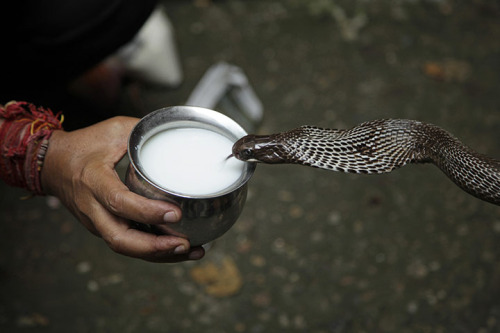A Milk-Drinking British Boa March 30, 2016
Author: Beach Combing | in : Modern , trackback
There are lots of tall tales about snakes and lots of tall tales about snakes taking milk from udders and breasts, but this is unusual for the apparent quality of the witness and its impact in the local countryside. The journalist who wrote, and doubtless loved researching, the initial piece was from the Birmingham Gazette. We are in 1910:
Something in the nature of rustic miracle has been worked in the little Gloucestershire village of Oddington, near Stow-on-the-Wold, and the news of it has spread in various forms all over the countryside. The main report appears to be that a cow deprived of its twelfth calf has taken to suckling serpents, though in some of the neighbouring villages the story has attained far more startling dimensions, and exciting yarns are told of farm hand’s struggle with a boa constrictor which he caught in the act of kidnapping a valuable Alderney cow. With a view to getting at the truth of these unsettling rumours, I visited Oddington Thursday afternoon, and, in consequence of interview with the bailiff of the Hon. Mrs. Rich, at whose property the phenomenon occurred, gleaned a surprising story, and was shown several incontrovertible proofs.
As always in these stories we begin with a good cow losing its milk. In 1700 there would have been a witch to blame, but in Edwardian England…
The story begins with the unaccountable failure of an Alderney cow to yield her customary supply of milk. Hitherto the reputation of Daisy, the animal in question, had been above reproach. She had borne twelve promising calves in thirteen years, and had supplied milk with the regularity of penny-in-the-slot machine. But without warning her generous fountains ran suddenly dry, and to quote ‘our Jarge’ my principal informant ‘Her didn’t yield not spot of milk for more’n two days.’ The farm bailiff, suspecting that gipsies or tramps must have got at Daisy’s supply, instructed the cowman to keep an eye on that excellent beast, which Jorge accordingly did, with surprising results. After a brief period of vigilance the honest fellow sought out the bailiff and made his report boldly as follows; ‘l’ve been a-waitin’, and I do know what be wrong with our Daisy. I’ve seed snakes.’ Now the farm hand who sees snakes is rarely encouraged. ‘Jarge,’ however, stuck manfully to his story, which was that had come upon Daisy lying on the grass with expression of bovine bliss upon her countenance ‘same if her bein’ tickled pleasantlike.’ He made the cow get up, and then to his astonishment saw two great snakes wriggle in the grass where she had lain. ‘I struck out stick’ quoth Jarge ‘and killed ’em dead. They’ve been a-suckin’ our Daisy’s milk this three days.’ Questioned as to the veracity of his tale, ‘Jarge’ with simple dignity, produced the snakes. The larger of the two said to have measured anything from three to five feet. Unfortunately. I was not able to see it. The proofs of the story which have been displayed for my benefit are
- A hook on the wall from which the snake hung.
- The identical piece of string with which it was attached thereto.
- The footprints of the multitude which came to view the dead monster.
- The manure heap in which it was finally buried.
- A smaller snake, presumably a distant relation of the deceased marauder.
Then there is the analysis. Note that hedgehogs and nightjars were accused of stealing milk direact from the teat, like snakes.
‘Jarge,’ I know not his other name – it may be Washington – performed some unsavoury excavation work, but the body of the slain reptile remained obstinately lost. Then I went into the meadow to interview Daisy. From her staid respectability of mien and her general air of bovine stolidity, one would hardly have accused her of nourishing vipers. Nevertheless her udders were swathed in rags and bandages, and these, on being removed, displayed cuts and scratches on the two fore teats which bore suspicious likeness to the marks tiny teeth. ‘Don’t tell me they was hedgehogses milked her,’ said ‘Jarge,’ ‘’cos I don’t believe in no such foolishness. If I hadn’t seed they two snakes with my own eyes I’d never have believed that neither, but I knows; it was they, ‘cos why? Soon ever they was killed she began to give her milk again all proper and natural.’ The dead monster is described by various witnesses having been of tremendous size, and of the girth of man’s arm, and the occurrence has revived a goodly crop of old rustic fables, such as the milking of goats by the nightjar or goat-sucker, and so forth. But the popular theory in the district which Daisy may be said to be well known is that, having been robbed of her calf, she lavished her motherly affection and plentiful store of milk on the first creatures that came to hand. And I reckon,’ said one village ancient, ‘that if ‘Jarge’ hadn’t been so hasty with they serpents she’d ha’ reared em up and trained ’em to bellow and give milk, same as cattle!
Source: Gloucestershire Echo (19 Aug 1910), 2


